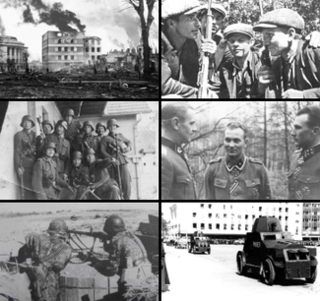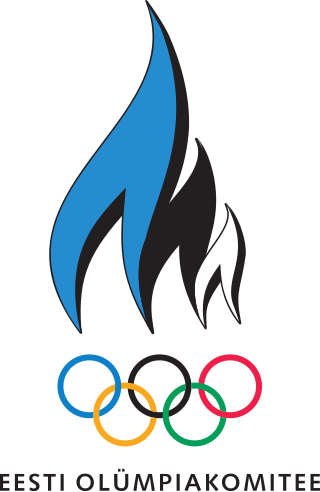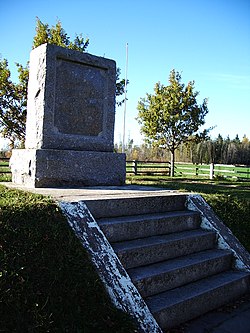
Viljandi is a town and municipality in southern Estonia with a population of 17,407 in 2019. It is the capital of Viljandi County and is geographically located between two major Estonian cities, Pärnu and Tartu. The town was first mentioned in 1283, upon being granted its town charter by Wilhelm von Endorpe. The town became a member of the Hanseatic League at the beginning of the 14th century, and is one of five Estonian towns and cities in the league. The once influential Estonian newspaper Sakala was founded in Viljandi in 1878.

Johan Laidoner was an Estonian general and statesman. He served as Commander‑in‑Chief of the Estonian Armed Forces during the 1918–1920 Estonian War of Independence and was among the most influential people in the Estonian politics between the world wars.

Estonia declared neutrality at the outbreak of World War II (1939–1945), but the country was repeatedly contested, invaded and occupied, first by the Soviet Union in 1940, then by Nazi Germany in 1941, and ultimately reinvaded and reoccupied in 1944 by the Soviet Union.

Viimsi is a small borough in Harju County, Estonia, about 9 km (6 mi) northeast of the centre of Tallinn, just north of Tallinn's subdistrict Merivälja. Viimsi is the administrative centre of Viimsi Parish. As of the 2011 census, its population was 2,341.

The Estonian Olympic Committee is responsible for Estonia's participation in the Olympic Games.
Kindral is the Estonian word for General which is also the highest military position in the Republic of Estonia. Both Ground Force and Air Force superior officers ranks share the same names which have been combined with the military rank of general and other senior officer ranks. There are four types of generals in the Estonia Defence Forces.

Viiratsi Parish was a rural municipality of Estonia, in Viljandi County.

Viiratsi is a small borough in Viljandi Parish, Viljandi County, Estonia. As of the 2011 census, the settlement's population was 1,332.
Vardja may refer to several places in Estonia:

Viljandi Parish is a rural municipality of Viljandi County, Estonia. It is located around the town of Viljandi, but does not include it.
100 great Estonians of the 20th century is a list of notable Estonians compiled in 1999 by Eesti Entsüklopeediakirjastus, Eesti Päevaleht, National Library of Estonia, Radio Kuku, and TV3.

The Commander of the Defence Forces is the Chief of the Estonian Defence Forces and the national defence organisations.
The Caucasus Grenadier Division was an infantry unit of the Russian Imperial Army. By the time of World War I, it was garrisoned at Tiflis and was part of the 2nd Caucasus Army Corps. It would later also take part in the Russian Civil War on the side of the White movement.

Vilnius Military School also known as the Vilnius Junker Infantry School was a military school for the non-commissioned officers (NCO) and junior officers of the Imperial Russian Army that operated in 1864–1915 in Vilnius. Up to 1910, the school prepared 4,371 podpraporshchiks and junior officers. During World War I, it relocated to Poltava and operated there in 1915–1918. In total, about 10,500 men graduated from the school, many becoming prominent military leaders and commanders in the post-war Eastern Europe.
This article lists events that occurred during 1934 in Estonia.

The Estonian War Museum is a war museum in Viimsi, Estonia. The museum is dedicated to military history of Estonia. The museum is named after Estonian general Johan Laidoner.

Paul-Adolf Lill was an Estonian military officer and Minister of War. He served in the Imperial Russian Army, participating in the Russo-Japanese War and World War I. Lill joined the Estonian Army during the 1918–1920 Estonian War of Independence, and held important staff positions. After the war he continued military service, holding posts of Chief of Staff of the Estonian Defence Forces, Undersecretary of the Minister of War, and from 1933 to 1939 Minister of War, reaching the rank of lieutenant general. With the onset of Soviet occupation, he was arrested by NKVD in 1941, and died in imprisonment the following year.

Gustav Jonson was an Estonian military soldier of the Russian Empire, Estonia, and the Soviet Union.
The Estonian coup d'état of 1934 was a bloodless military coup organized on March 12, 1934 by State Elder candidates Johan Laidoner, Konstantin Päts, and August Rei, who took part in the State Elder elections scheduled for April of the same year, during which Lieutenant General Laidoner and acting State Elder Päts had several Vaps leaders and activists, supporters of the fourth State Elder candidate Andres Larka, arrested. Päts, in violation of the constitution, appointed Laidoner as the commander-in-chief of the defense forces and decreed a stop to the election process for State Elder and the Riigikogu.















